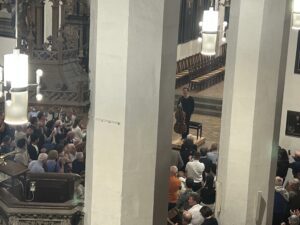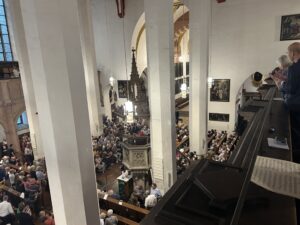


Going to see Jean-Guihen Queyras play all 6 Bach cello suites was an incredible and unique experience. As a double bassist, I have only played a couple movements from some of the earlier suites, but I have several close string player friends who have played more of the suites, so I am very familiar with several of them (mainly the first 3). The later suites I believe seem to be much more difficult, so I have very rarely heard those played. It was amazing seeing Queyras play all 6 nearly flawlessly, completely memorized too! The concert was a bit long, but quite engaging, because it inspires me greatly watching someone play over 2 hours of music memorized and enjoying themselves the whole time. As someone who really enjoys performing solos from memory, I hope to be able to do a similar thing someday.
There were a couple things (many things actually, but a couple worth mentioning) in the performance that particularly impressed me. One of them I’ve already mentioned: Queyras’s ability to play over 2 hours of music completely memorized, and not getting tired! It takes a huge amount of work and dedication to be able to do that. The second thing was about one of the suites in particular, I believe suite no. 5. Looking at the score, I noticed this suite was written with a different tuning: the A string was tuned down to a G. It took me a while to notice this, but I noticed that the score was written with only the notes played on the A-turned-G string were transposed. So for example, if you had a C minor rolled chord with a low C2+G2+Eb3+C4, the chord itself would be written with the same bottom 3 notes, but the top note, C4, would be written as a D instead. I realized later this is because when a cellist sees a D written, they will automatically place their 4th finger down in 1st position (I think, speaking as a bassist here where everything is way different…). But with this new tuning, that finger placement will sound as a C instead. So I think having the notes on the top string written transposed is helpful to the cellist to make it easier to read and play, but the reason this caught my attention was because as someone with perfect pitch, reading transposed music is very difficult. For example, I used to play clarinet in high school for pep band, and I would always struggle reading even simple music because I would see a G written, and then I would hear an actual G in my head, place the fingers down that I know make the sound of a G, and then realize that the note that sounds like a G on a clarinet is actually an F, so I’m playing the wrong note! I would associate fingerings on clarinet with the notes they sound like, rather than like a typical clarinetist who would associate fingerings with the transposed notes. It was because of this that the 5th cello suite particularly impressed me.
Overall, this was an amazing performance. Watching the suites played in this way gave me a new appreciation for them and made me want to become more familiar with them. This summer, I want to potentially try to play some more of these on either bass or bassoon.
(Included the last picture for fun, I enjoyed trying to see where Bach’s initials are in the logo on the organ!)